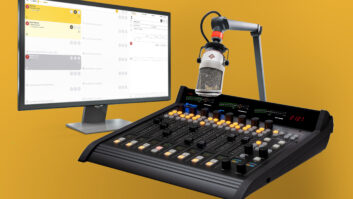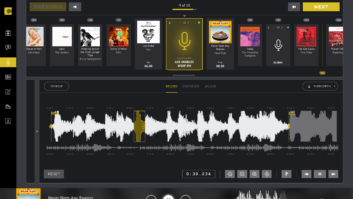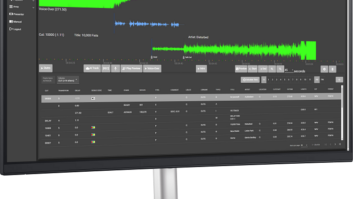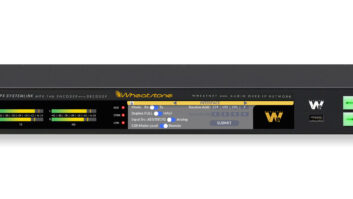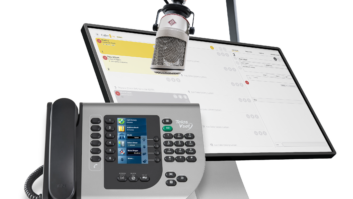
The recent announcement in the United Kingdom of the first RadioDNS-enabled radio receiver — Pure’s Sensia model — has been received by responses ranging from ecstatic to ho-hum. Many radio folk in the United States are still trying to figure out what it even is.
To help those in the latter category: The Sensia is a tabletop radio sold in the U.K. that receives FM and DAB broadcasts and includes built-in WiFi that allows it to receive visual enhancement content from radio stations (via the Internet), to be displayed on its 5.7-inch (diagonal), 640×480 touchscreen. Numerous U.K. broadcasters are already providing synchronized enhancement content to Sensia users there.
Under the hood
The RadioDNS open standard, which was discussed in the Sept. 9 issue, enables this process.
RadioDNS allows the radio automatically to find an appropriate Web site when a station’s over-the-air signal is tuned.
Sensia also implements a specific application of the RadioDNS system called RadioVIS, short for “Radio Visualisation,” which addresses how the visual enhancement content should be formatted by broadcasters and displayed by receivers.
The RadioVIS draft specification establishes messaging and subscription protocols, by which a user quickly can select a program-related image or synchronized slideshow to be delivered to the receiver via its Internet connection. The spec also presents display recommendations to receiver manufacturers on preferred screen size, resolution, aspect ratio, image-scaling parameters, buffer size and the like.
Details and the draft specifications are available at radiodns.org.
The ‘I-word’
The currently preferred term for the device class of which Sensia represents the vanguard is “connected radio.”
Few have used the term “interactive radio” to describe it, but that’s essentially what it is. Whatever you call it, it bears a potentially worrisome resemblance to the many attempts to bring interactivity to the television world.
So let’s look at the similarities — and differences — between interactive TV (iTV) and connected radio, and perhaps define a course whereby the new radio option might succeed where its television predecessors have not.
First recall that the term “interactive TV” has been applied to many things over the years. At its broadest, iTV can be defined as anything that moves beyond standard television content to allow user choice on what is presented (beyond traditional channel selection and volume, of course).
Although today’s popular TV EPGs and DVRs originated in the iTV space, what most often comes to mind among broadcasters when discussing “interactive television” per se is the additional, program-related content that it could provide, which is where iTV generally is considered a massive flop.
Yet these so-called “enhancement” features are what RadioDNS largely promises to bring to the radio environment. Can it, or will it, do any better at this than iTV did?
Similarities and differences
To get a good answer, let’s probe deeper.
Like RadioDNS, iTV required purchase of new equipment by the consumer (the interactive set-top box). It also required the transmission of additional data over the air (in a standard form) by broadcasters — which RadioDNS does not. This implies that iTV was subject to a classical chicken-and-egg problem, which RadioDNS largely could avoid.
You may further recall that the iTV market fragmented among multiple proposed “standards” (initially ATVEF, Liberate, JavaTV and others, subsequently followed by standardization attempts in ATSC-DASE, DVB-MHP, ACAP, OCAP, et al.). This and the above chicken-and-egg issue combined to doom the technology to failure, since neither broadcasters nor consumers were ever comfortable choosing a format by which to either deliver or receive iTV content. Two variables = no single solution.
In contrast, RadioDNS leverages the Internet’s ubiquitous, uniform deployment, and (at least to date) it stands alone as an open standard for presenting radio enhancement content.
Admittedly it’s still early, but we can at least hope that implementers realize the value of a level playing field, and continue to follow the singular, open and low-cost approach that RadioDNS provides, thus avoiding the dreaded fragmentation. (Note that ATVEF and some other iTV formats also leveraged the Internet for delivery of enhancement content, but this couldn’t overcome the fragmentation issues.)
Meanwhile, there was another approach to iTV that fared somewhat better for awhile: the so-called two-screen method, utilized most notably by ABC-TV in the early 2000s.

Sensia is a tabletop radio sold in the U.K. that receives FM and DAB broadcasts and includes built-in WiFi that allows it to receive visual enhancement content from radio stations via the Internet, to be displayed on a touchscreen. This technique avoided the format-fragmentation issue by delivering all enhancement content via the Internet to PCs in the same room with the television. The only real connection between the two delivery systems was an occasional announcement on the TV broadcast of the URL for the interactive content.
This worked pretty well for awhile, and no new hardware or commitment beyond a PC and Internet access was required. For example, it allowed TV viewers in Internet-enabled households to play along with game shows like the “Who Wants to Be a Millionaire?” on their PCs as the live program was broadcast. (Cleverly, the online component for this program only displayed the multiple-choice answers — viewers had to watch the TV show to get the questions.)
Ultimately the extra effort wasn’t deemed worth the expense by the program’s producers, however, and this two-screen iTV “format” also evaporated.
RadioDNS can split the difference between these approaches, utilizing the Internet’s broad availability with the need only for new receiver hardware of a single format. Broadcasters need not add anything to their transmissions, and only have to provide a new link or redirect-pointer at their Web site, plus a little optimization of online content for display on new, small-screen devices (which they should already be doing for mobile Internet users anyway).
No pain, no gain
Sure, it’s more work for radio broadcasters to provide a real-time enhancement stream to these devices, but third parties are already emerging for this purpose. And while broadcasters are waiting for RadioDNS devices to be deployed, this new content could be viewed on traditional Internet browsers on PCs and handhelds, used alongside a traditional radio like the old two-screen iTV approach.
Anyway, the fact that additional effort is required to succeed in the new-media world is a given. Radio must compete by improving and extending its services into the digital environment, largely through the addition of program-related metadata. It’s not just “going digital” that sells it to consumers; it’s what new content and service the digital technology delivers.
The palette that RadioVIS offers for this metadata presentation is a far cry from what most leading-edge radio stations do today in getting jiggy with an eight-character text display for title and artist data on RDS. It could actually make radio programming fun again, and provide significant attraction for next-gen creative types.
Meanwhile, the kind of enhancements that RadioDNS offers could be the real difference-maker for “digital radio,” and finally convince a critical mass of audience that it’s now worth plunking down some bucks for a new receiver because it truly offers enough obvious, additional functionality to be worth it.
This could be what it takes to create a true digital radio platform. Oh, and by the way, HD Radio could hitch a ride on this deployment train by being incidentally on-board the RadioDNS-enabled devices.
Given all these potential advantages, it’s therefore not too grandiose to conclude that the best-case convergence potential of “connected radio” enabled by RadioDNS could ensure the very survival — and perhaps the future prosperity — of radio broadcasting.
Skip Pizzi is contributing editor of Radio World. Follow him on Twitter attwitter.com/skippizzi.





